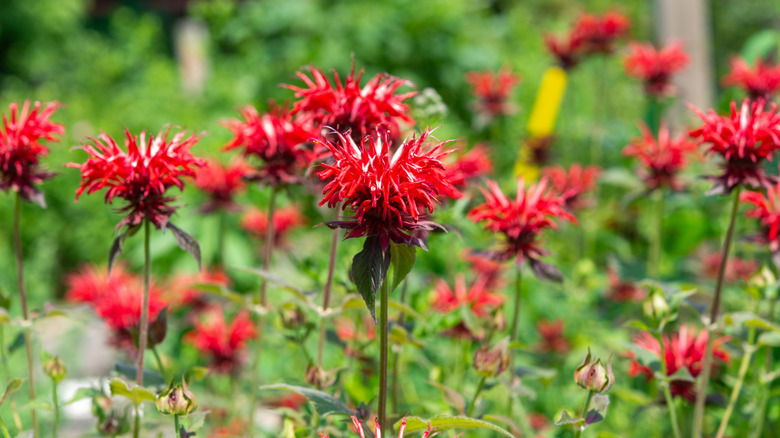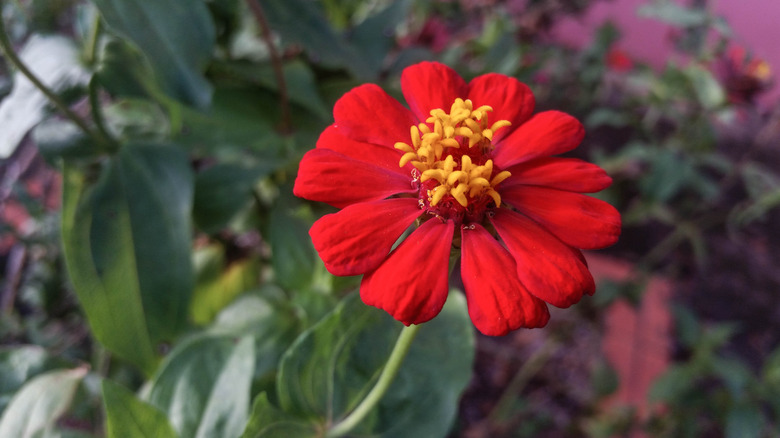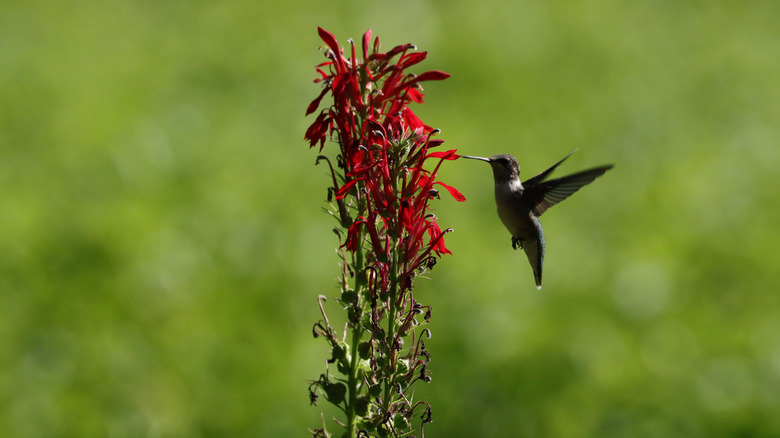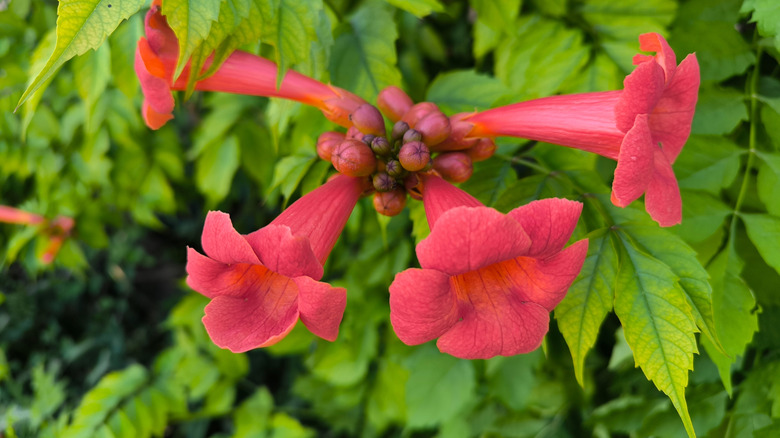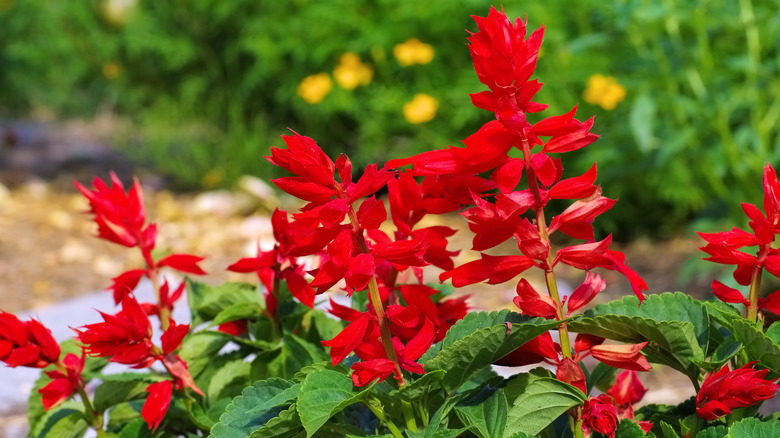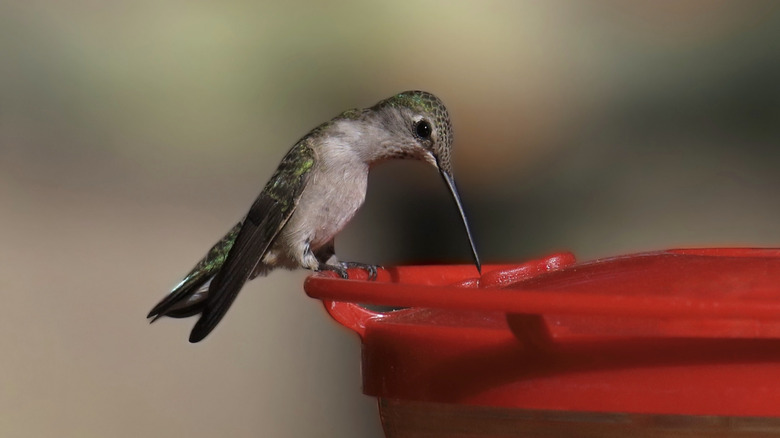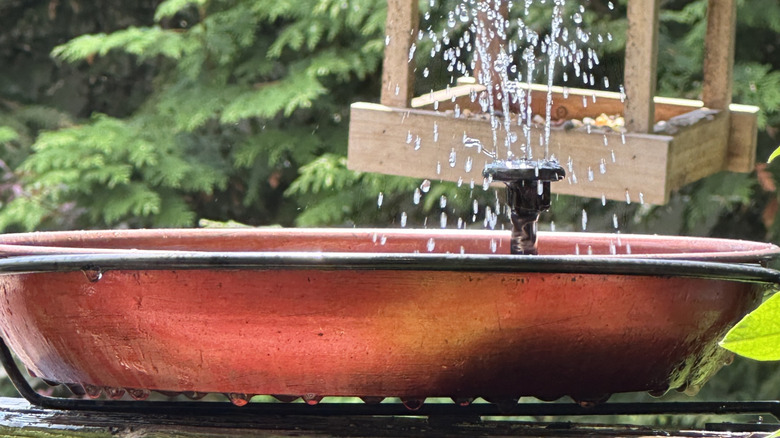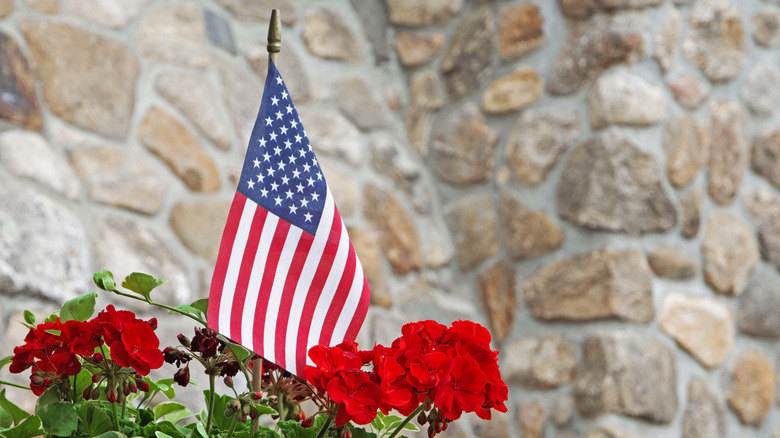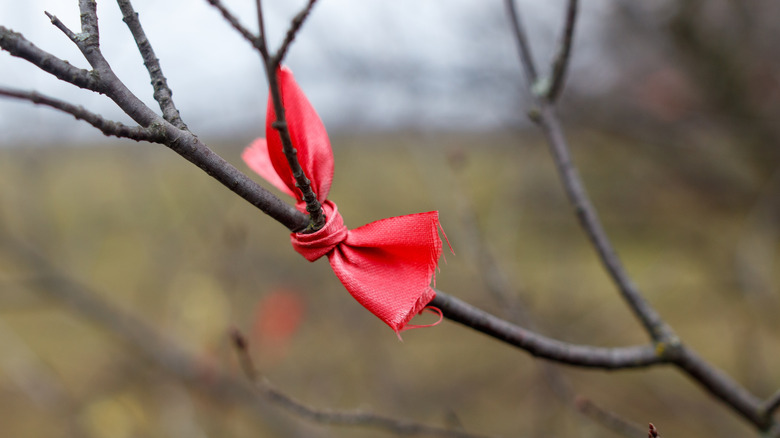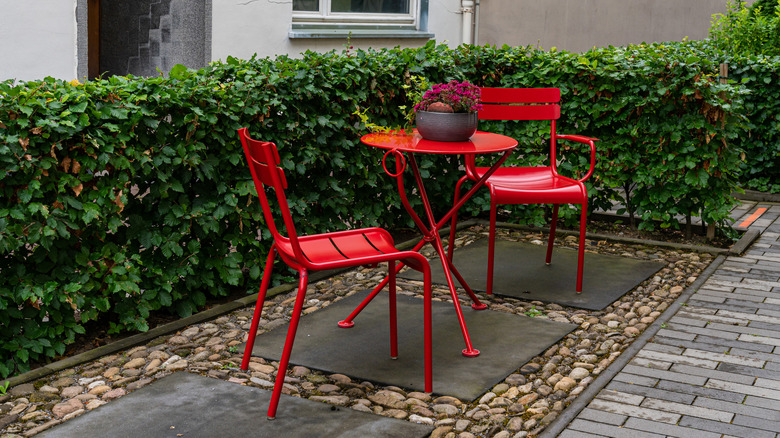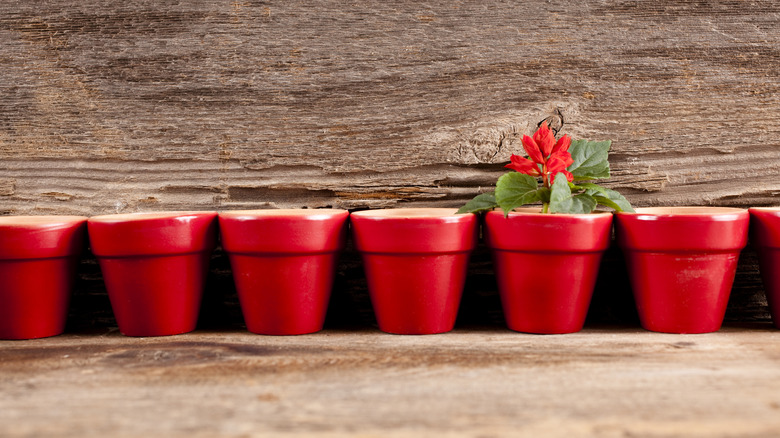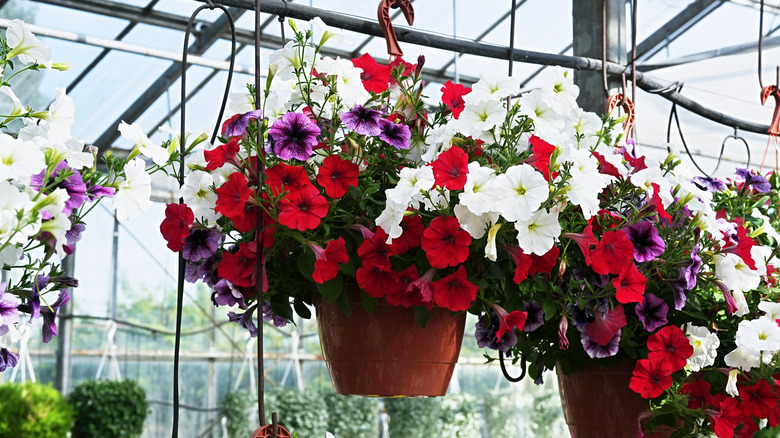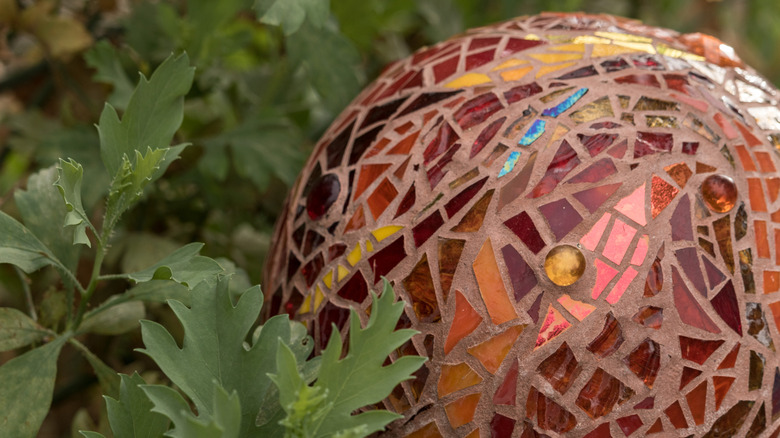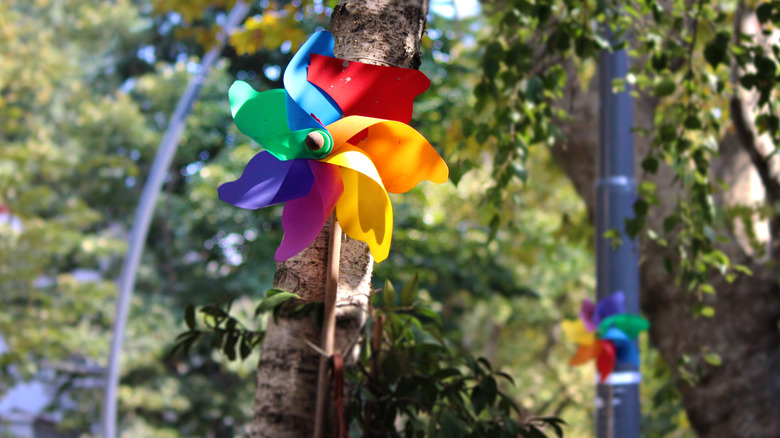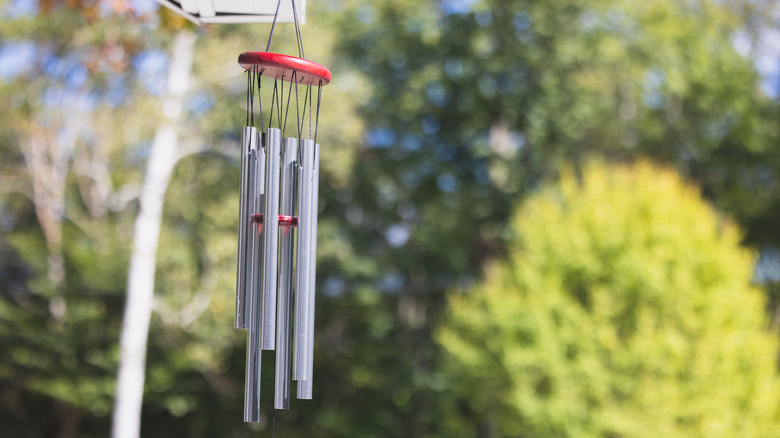15 Ways You Can Use The Color Red To Turn An Outdoor Space Into A Hummingbird Haven
If you're anxious to see hummingbirds in your yard or garden, know there are numerous ways you can help attract them, and one of the most popular is to utilize the color red. This is because hummingbirds have surprisingly strong color vision and may be able to spot bright red colors from afar. Hummingbirds are also drawn to red because they associate the color with sources of food.
Native flowers, other sources of nectar, and water dispensers are key spots you might be able to incorporate the color red, and they should be prioritized as such. Red flowers are among the best ways to help lure these birds to your outdoor spaces, as hummers tend to be most attracted to red and orange blooms. Also, rather than having a single type of flowering plant in your yard or garden, hummingbirds might be more likely to stop by if you have multiple types. Some of their favorites include zinnias, trumpet creepers, beebalm, and many others.
However, if you're not seeing hummingbird activity, you can consider a few other ways to incorporate red outdoors to help grab their attention and then feed from your garden. While stagnant red-colored items can help, you can also try incorporating certain outdoor pieces that move in the breeze — doing so might garner a hummingbird's attention even more. There are many ways you can attract hummingbirds with the color red, so it's time to get creative while also supporting your favorite birds.
Beebalm
Beebalm (Monarda) is a perennial plant native to North America that attracts a variety of species during the spring and summer months when its flowers are in bloom. While the plant's clusters of shaggy-like flowers don't seem likely ro attract pollinating species, beebalm happens to be a hummingbird favorite because of its small, tubular-shaped petals that are easy for them to feed out of. Choosing red cultivars will help draw hummingbirds even more, and you could spot bees and butterflies around the flowers, too. To successfully grow beebalm plants, know that they are best suited for USDA Hardiness Zones 4 to 9.
Zinnias
You might also be able to attract more hummingbirds with a garden flower that's easy to grow from seed: zinnias. These annuals are native to southwest portions of the U.S., so they're great for hot, dry environments. Because of this, it's important to make sure they are planted in well-draining soil. Zinnias are best planted in USDA Hardiness Zones 3 to 10, and they are available in red, along with other vibrant colors. Taller zinnia varieties may be best for attracting pollinators, with some growing up to 4 feet tall.
Cardinal flowers
Cardinal flowers (Lobelia cardinalis) are another type of red-flowering perennial plant that hummingbirds love. They grow well in USDA Hardiness Zones 3 to 9, but be aware that they prefer lots of water and moist soil. Hummingbirds feed from these beautiful red flowers, and in the process, they'll help to pollinate them. As a bonus, cardinal flowers are native to large portions of the U.S., and they have the ability to self-seed for future seasons. Consider planting them along borders around your garden or landscape beds as show-stopping plants that will also draw hummingbirds to your home.
Trumpet creepers
Also known as trumpet vines, trumpet creepers (Campsis radicans) are attractive to hummingbirds both because of the bright colors of their flowers and their tubular-shaped petals. Perhaps the biggest downside to trumpet creepers is their weedy nature. For this reason, you might think twice before planting this beautiful vine in your garden as a shrub. Instead, consider growing red cultivars over fences and trellises to also help attract hummers if you have a lot of yard space. You can expect these drought-resistant plants to grow best in USDA Hardiness Zones 4 to 10.
Salvias
Salvia (Salvia officinalis) plants are another low-maintenance option you can plant in your garden to draw hummingbirds. Not only are these plants coveted for their ornamental qualities, but pollinators like hummingbirds love them, too. Hummers might visit any color of salvias. However, since red cultivars are available, you might start with one like 'scarlet sage' (Salvia splendes), which produce beautiful tubular flowers that both you and hummingbirds are likely to appreciate. In general, salvias do best in USDA Hardiness Zones 5 to 10, and they prefer full sun with well-draining soil.
Hummingbird feeders, excluding their nectar
It can sometimes take several days for hummingbirds to find feeders. This is where choosing a red-colored feeder can help. Unfortunately, some people erroneously use commercial red dye-containing hummingbird nectar in an attempt to draw hummingbirds to their yards, or they might add red food coloring to homemade nectar. Homemade hummingbird nectar is surprisingly easy to make, but you should never add red dye. These chemicals are toxic to these small birds. Choosing a red-colored feeder with dye-free nectar is adequate enough to draw these birds to your outdoor spaces.
Birdbaths and water features
While traditional birdbaths are much too large for hummingbirds, they will likely appreciate access to a smaller, shallower version that they can drink from easily. As a bonus, a bath with a sprayer or other similar water feature can also grab their attention while allowing them to drink water on the go. If you're wanting to ensure as much visibility with your birdbath as possible, consider choosing one in a red color or pattern.
Garden flags
Sometimes hummingbirds may not visit your yard or garden right away, even if you have a variety of flowering nectar plants, a nectar feeder, and water. This is where outdoor accent pieces can help. Garden flags have the advantage of adding some character to your yard while also catching the wind in a way that may draw a hummingbird's attention. You can choose flags that are solid red, or have some fun with bright-colored patterns that include this hue.
Napkins, bows, or ribbons
One easy and affordable way to draw hummingbirds' attention is to add small red items around your yard that can move in the wind. These can include red-colored napkins, bows, or ribbons. Consider affixing these items to feeders, tree branches, fence posts, and anything else high off the ground that a hummingbird might see while zipping by. Also know that you don't need to hang a bunch of ribbons around your garden for the entire season — once hummingbirds start visiting your outdoor spaces, you can take these items down.
Furniture
While it can be helpful to draw hummingbirds with flowers and outdoor accessories that move in the wind, you shouldn't discount stagnant sources of the color red, either. Aside from a red hummingbird feeder and a water feature, you may also be able to help attract these birds with red furniture. If you don't want to invest in all-red tables and chairs, consider key accent pieces to give your patio some character. Ideas include a red bench, Adirondack chair, or lounger.
Containers and pots
If you have a container garden or various potted plants around your home, you might consider giving them a fun upgrade with hummingbirds in mind. Having a few red-colored containers or brightly-patterned pots may draw the attention of these birds even further. It's also another way to add some interest to your garden area. If the plants grown in these containers don't produce nectar-containing flowers, consider placing them around other items in your outdoor spaces that hummingbirds will visit to keep them coming back.
Hanging baskets
Not everyone has space around their homes for traditional planters. As an alternative, consider using hanging baskets to plant some hummingbird-friendly plants. To increase the impact, consider buying red-colored baskets and growing nectar-containing flowers. Just be sure that whichever basket you select is at least 12 inches wide and 8 inches deep so that the flowers have enough room to grow and last throughout the season. You can then fill them with a variety of gorgeous hanging basket plants that hummingbirds absolutely love, with a focus on red flowers.
Mosaic gazing balls
Gazing balls are another fun option for adding some color to your outdoor space. They come in a variety of types and sizes, with some large enough to require their own pedestals. Some versions even contain solar lights that allow them to glow after sunset. For the sake of drawing hummingbirds, consider choosing a red, dark pink, or purple gazing ball with mosaic patterns. These will sparkle beautifully in the sun during the day and just might capture the eye of a tiny bird flying by without confusing them if they see their own reflections.
Wind spinners
Wind spinners are another budget-friendly way to attract hummingbirds to your yard or garden. As their name suggests, these garden accessories spin in the breeze while adding visual interest to your outdoor space. Hummingbirds and other pollinating species may also catch a glimpse of the spinners and want to check out your garden. The patterns on these are seemingly endless, and some people even choose wind spinners shaped like birds. The key is to pick a spinner with red in it if your purpose is to try to attract hummingbirds.
Small wind chimes
If you don't mind having a bit of noise in your backyard, hanging up a wind chime may also help to attract hummingbirds. The keys for success are to choose chimes that have red in them, and to not hang them too close to hummers' food sources. If you're wondering whether your lawn décor may be the reason hummingbirds aren't visiting your yard, it could be that the wind chimes are too loud for their liking. To prevent this, consider smaller chimes or sun catchers with bright red colors that will attract hummers without scaring them.

